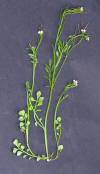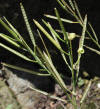WILD
FOODIES' HOME PAGE
PLANT PROFILE LIST
NAME: Bittercress
SPECIES / FAMILY: Cardamine Hirsuta / Brassicaceae
OTHER COMMON NAME(S): Hairy Bitter Cress
CONDITIONS: sun
(recipes)
|
PARTS: |
EDIBLE |
TASTE |
RAW/COOK |
SEASON |
|
All |
|
|
|
|
|
Shoots |
|
|
|
|
|
Leaves |
|
pepper/mustard |
RAW/COOK |
Winter-Spring |
|
Buds/Flowers |
|
pepper/mustard |
RAW/COOK |
Winter-Spring |
|
Fruits |
|
|
|
|
|
Roots |
||||
|
Seeds |
|
|||
|
Nuts |
|
|
|
|
|
Pods |
|
|
|
|
|
Stalk/Stem |
|
|
|
|
|
Bark |
|
|
|
|
PORTION: small
COMMENT: This great little winter-time Cress (in the Mustard Family) is easy to harvest with a twist and pinch of its stem. Voila! You have a tiny little Cress Bouquet! But you must cook or process it pronto, as it quickly turns yellow and wilts. You can eat it raw, boil it in salted water, or swish it in a salted oily bowl (I use Walnut Oil), then bake. It is often found in gardens and other disturbed soil. // The plant germinates most freely in the autumn and so leaves are usually available all winter. Leaves and flowers used as garnish or in salads or soups. (1) While C. pensylvanica is the most common locally the only native one is C. concatenata, or Cutleaf Bittercress. The Iroquois used it as food, raw, with salt or cooked. The roots can be mashed and used as a horseradish substitute. (2)
CAUTION: As with any hot and spicy food, eat in moderation.// "It was also considered slightly hallucinogenic."(2)
NUTRITION/MEDICINAL: "It was also used as a medicine (by the Iroquios). They mashed the roots and used them to treat headaches, colds, to encourage the appetite, for heart problems and injuries. It was also considered slightly hallucinogenic."(2) It contains glucosinolates which are known to help remove carcinogens from the body. It also contains, vitamin C, beta-carotene, and possibly lutein which is known to help reduce vision problems including cataracts.(5)
LOOK-A-LIKES: Like other cresses such as Shepard’s Purse https://en.wikipedia.org/wiki/Capsella_bursa-pastoris
POISONOUS LOOK-A-LIKES:
OTHER USES: The tiny flowers are attractive to a few early butterflies, including (in the United States) spring azure (Celastrina ladon) and falcate orange-tip (Anthocharis midea).(1)
SOURCE LINKS (may include nutritional and medicinal info, plus other uses):
- https://pfaf.org/user/plant.aspx?LatinName=Cardamine+hirsuta
- https://www.eattheweeds.com/bittercress-and-kissing-crucifer-cousins
- https://en.wikipedia.org/wiki/Cardamine_hirsuta
- http://www.foragingtexas.com/2006/12/bittercress.html (good photos)
- http://www.eattheplanet.org/bittercress-a-nationwide-herb
- https://www.juliasedibleweeds.com/general/bittercress-a-warming-winter-weed (recipes)
- https://huntergathercook.typepad.com/huntergathering_wild_fres/2013/01/hairy-bittercress-pesto.html (recipes)
- https://www.wildedible.com/bittercress
- https://foragingguru.com/hairy-bittercress
- https://britishlocalfood.com/hairy-bittercress
- https://ediblewild.info/plants/hairy-bittercess
- https://greg.app/hairy-bittercress-edible



